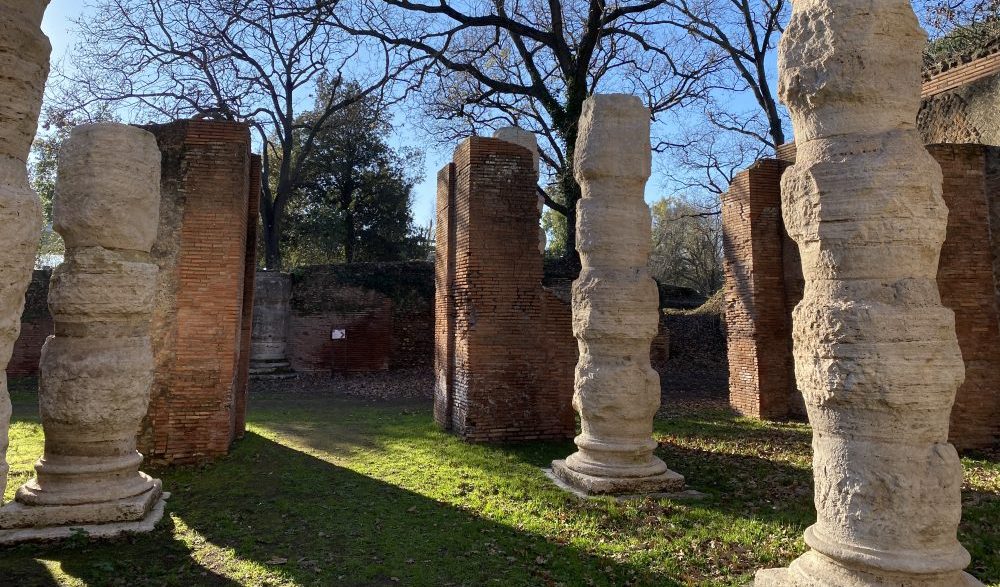46 AD the emperor Claudius built a port 3km north of Ostia, the Portus Ostiensis Augusti.
64 AD the port was inaugurated by Nero.
100-112 AD Apollodorus of Damascus on behalf of Trajan adds the hexagonal basin to the port of Claudius.
537 AD invasion of the Goths, the citizens of Portus fled, depopulating the city for the benefit of other better defended settlements.
At the beginning of the first century B.C. Rome was close to one million inhabitants. Most of the food necessary for its livelihood passed through Ostia, a canal port at the mouth of the Tiber, which soon became insufficient and inaccessible to larger ships.
In 46 A.D. the emperor Claudius decided to build a port 3 km north of Ostia, the Portus Ostiensis Augusti.
Two piers closed an immense basin of 150 hectares, with the entrance indicated by a lighthouse founded on an artificial island. Two canals connecting with the Tiber made it possible to reduce the effect of the floods in Rome and made transport easier.
Inaugurated by Nero in 64 AD. however, the port was too large and between 100 and 112 AD. the emperor Trajan had a 36-hectare hexagonal basin built inside that of Claudius. Over time the port became a city, Portus, whose role was fundamental for the development of the capital and which, despite its small size, remained in operation until the early Middle Ages.

To allow the hauling of the ships that went up the Tiber, a road ran along the banks and along the way there were landing places for the stops.
Almost three days of river navigation were necessary to cover the 35 km that separated the port complex of Ostia-Portus from Rome. For the descent, boatmen used the Tiber current.

Boat shooting continued to be practiced on the Tiber until the modern era. Transport by water allowed bulky and heavy goods to travel over long distances. In Roman times, a medium-sized transport ship could load around 150 tons and arrive in Ostia from Cadiz or Alexandria in Egypt in a week.
Rome between the 1st and 4th centuries AD it was a huge city and the main market of the
Mediterranean.
All kinds of merchandise, metals, wood, marble, luxury goods arrived here from every province and from the centers outside the borders of the empire, without forgetting wheat, the staple food of the population.
According to Flavius Joseph, who lived in the 1st century AD. each year 150,000 tons of wheat arrived in Rome from Egypt alone, enough to feed the city for four months. The other widely consumed products were wine, oil, used not only for food but also for lighting and body hygiene, and a very popular fish sauce, the “garum“.






















Museums and archaeological areas:
Imperial Harbours of Claudius and Trajan
Necropolis of Portus in the Isola Sacra
Archaeological area of Ostia antica
Museum of the Roman ships from Fiumicino
Private park:
Portus nature reserve
Sources:
Romano Impero
Imagining Portus
Useful information to prepare the visit:
The memory of Portus has been erased over the centuries, an effort must be made to retrace its history and reconstruct its image.
From 1976 to 1984 in this area you could see lions, monkeys, giraffes, elephants and even rhinos in the wild, here in fact there was the Rome safari owned by the Torlonia family.
Istituto Luce – Pubblicità: 1976
Lo Zoo safari di Fiumicino. 5000 lire a macchina.
A part was expropriated giving life to the Archaeological Park of the Port of Rome. But a part is still owned by the family and is managed as a protected oasis by an association of volunteers. Today it is possible to admire on the Trajan basin beautiful migratory birds such as the gray herons and to meet fallow deer in freedom.
To access the Trajan basin, you must book a visit to the Oasi di Porto association: Via Portuense n ° 2264, (00050) Fiumicino RM, Secretariat of the Oasi di Porto Consortium tel. +39 06/5880880
The excavations of the port of Rome are next door and the entrance is FREE.
It is also worth visiting the Museum of Roman Ships – via Alessandro Guidoni, 00054 Fiumicino – FREE admission – where it will be possible to admire 4 ancient ships found in the 1960s during the construction of the Fiumicino airport.

